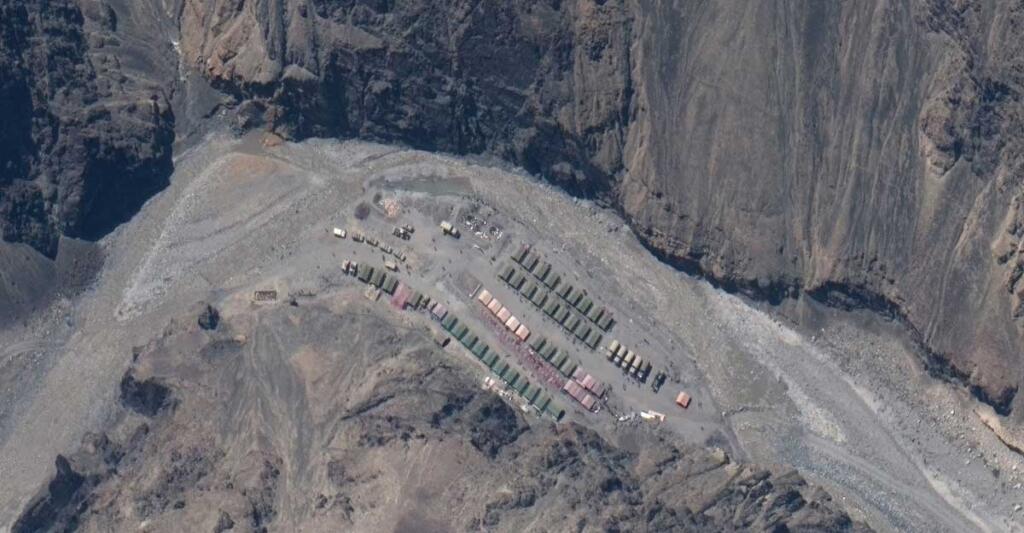China has once again drawn attention with its latest construction project near the Line of Actual Control (LAC) in Ladakh. The completion of a 400-metre bridge connecting the north and south banks of Pangong Lake has sparked concerns about India’s security in the region.
China’s Bridge: Location and Details
The newly built bridge is located about 25 km from the LAC. Satellite imagery reveals vehicles already using this structure, which spans the narrowest part of Pangong Lake in Khurnak. This development has caught the eye of various media outlets and satellite imagery experts.
China started constructing this bridge in 2022, with experts predicting its quick completion. The structure can reportedly support heavy military vehicles, including tanks and armored personnel carriers.
Impact on Travel Times and Military Capabilities
China’s new bridge significantly cuts down the distance between the southern and northern banks of Pangong Lake. Before, Chinese forces had to travel a 180-km loop through Tibet’s Rutog county to reach the south banks from Khurnak. The bridge now offers a direct and shorter route for fast troop deployment.
China’s Bridge: A Worry for India
The bridge’s location near Pangong Tso is troubling for India, as it shows China’s expansionist aims in Ladakh. Military experts point out that this infrastructure improves China’s ability to quickly move forces between the north and south banks of the lake, a skill they lacked before.
Strategic Advantages for China
The bridge gives China several strategic benefits:
1. Shorter response time in conflict situations
2. Better access to areas in the southern banks, like Rezang La
3. Stronger deterrence posture
China’s Ongoing Infrastructure Development
The bridge is part of China’s larger efforts to improve its infrastructure along the LAC. Since the 2020 Galwan clash, China has greatly increased its activity across all sectors of the 3,488-km LAC, from Ladakh to Arunachal Pradesh.
China’s infrastructure projects include:
– Building dual-use ‘Xiaokang’ villages
– Constructing a road from Samzungling to Galwan Valley
– Developing tunnels, helipads, and bunkers
– Deploying more military aircraft in the region
India’s Response and Political Reactions
While India hasn’t officially responded to the new images, sources suggest that the country has taken steps to strengthen its own infrastructure to match China’s efforts.
Political Opposition’s Concerns
Opposition leaders have raised questions about the strategic consequences of China’s bridge construction. They have criticized the government’s perceived silence on the issue and called for a more active approach to addressing China’s actions along the LAC.
Historical Context and Ongoing Tensions
China’s activities in the region have been a source of concern for India for decades. The country has occupied areas around Pangong Lake since the 1960s, a fact that India has consistently disputed. The completion of this new bridge is seen as another step in China’s efforts to solidify its presence in the contested region.
The tensions between India and China along the LAC have been particularly high since the 2020 Galwan Valley clash, which resulted in casualties on both sides. Since then, both countries have been engaged in diplomatic and military talks to ease tensions, but progress has been slow.
Implications for Regional Stability
China’s continued infrastructure development along the LAC has broader implications for regional stability. The improved connectivity and military capabilities provided by structures like the Pangong Lake bridge could potentially alter the balance of power in the region.
India’s Challenge: Balancing Act
For India, the challenge lies in effectively responding to China’s actions while avoiding escalation. This involves a delicate balance of diplomatic negotiations, military preparedness, and strategic infrastructure development.
Looking Ahead
As China continues to enhance its infrastructure along the LAC, India faces the ongoing challenge of responding effectively to maintain its strategic position in the region. The situation calls for careful monitoring and strategic planning from Indian authorities to ensure national security interests are protected.
The completion of China’s bridge over Pangong Lake marks another significant development in the complex and ongoing border dynamics between China and India.
